22 Sep 2014
UNWTO Congress Merges Power of Pilgrimages & Tourism to Drive Spiritual & Material Growth
Santiago de Compostela, Galicia, Spain — The global travel industry took another giant leap forward with the organisation of the first Congress on Tourism and Pilgrimages in this historic UNESCO World Heritage site city between 17-19 September. In what proved to be a unique interaction, religious leaders of all castes and creeds became tourism promoters, and tourism executives learnt that there was a much loftier and deeper dimension to travel than just load factors, asset value, social media and RevPar.
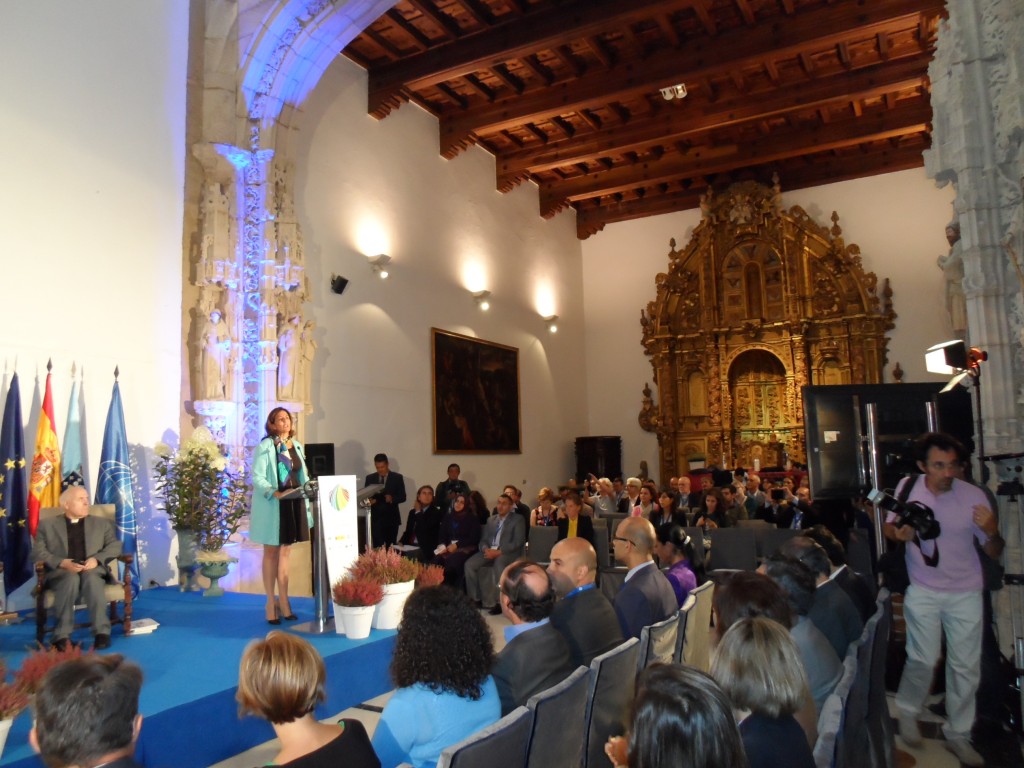 Isabel María Borrego Cortés, Secretary of State for Tourism, Ministry of Industry, Energy and Tourism, Spain at the podium |
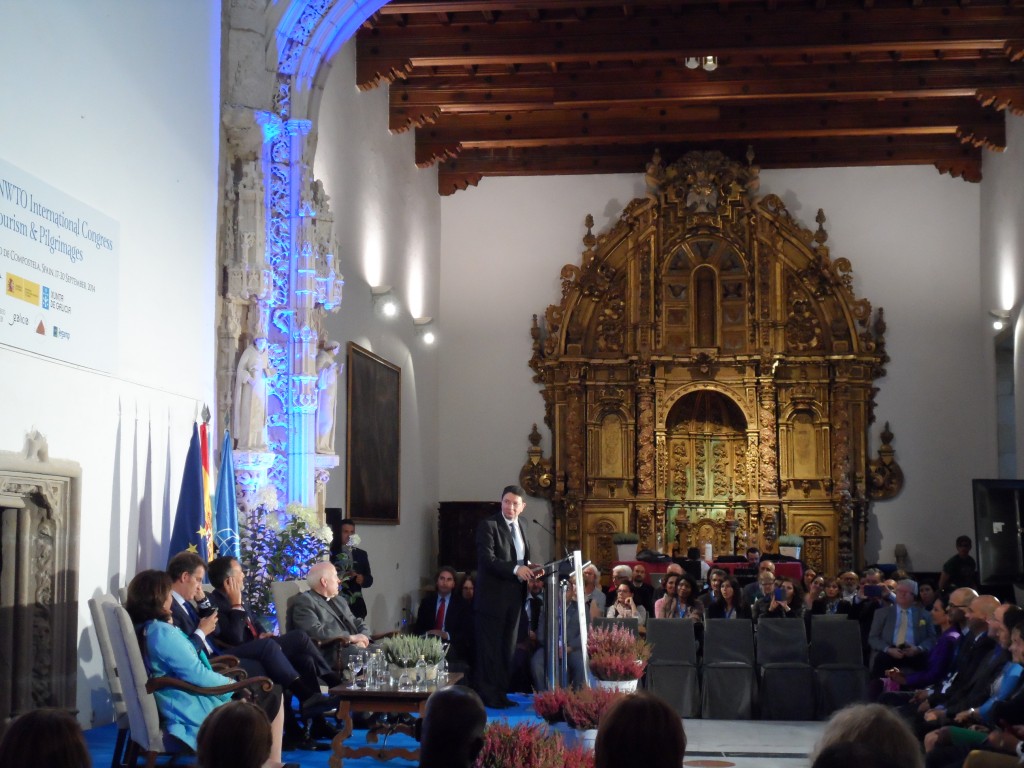 Taleb Rifai, UNWTO Secretary-General |
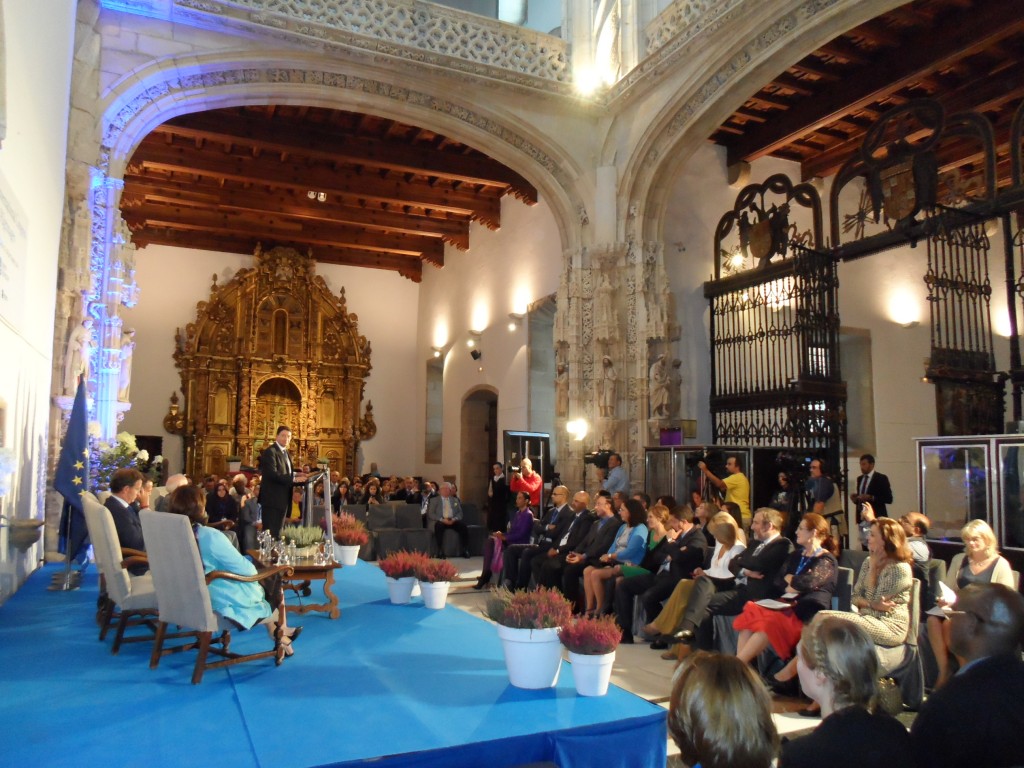 A more panoramic view of the magnificent hall where the proceedings took place. |
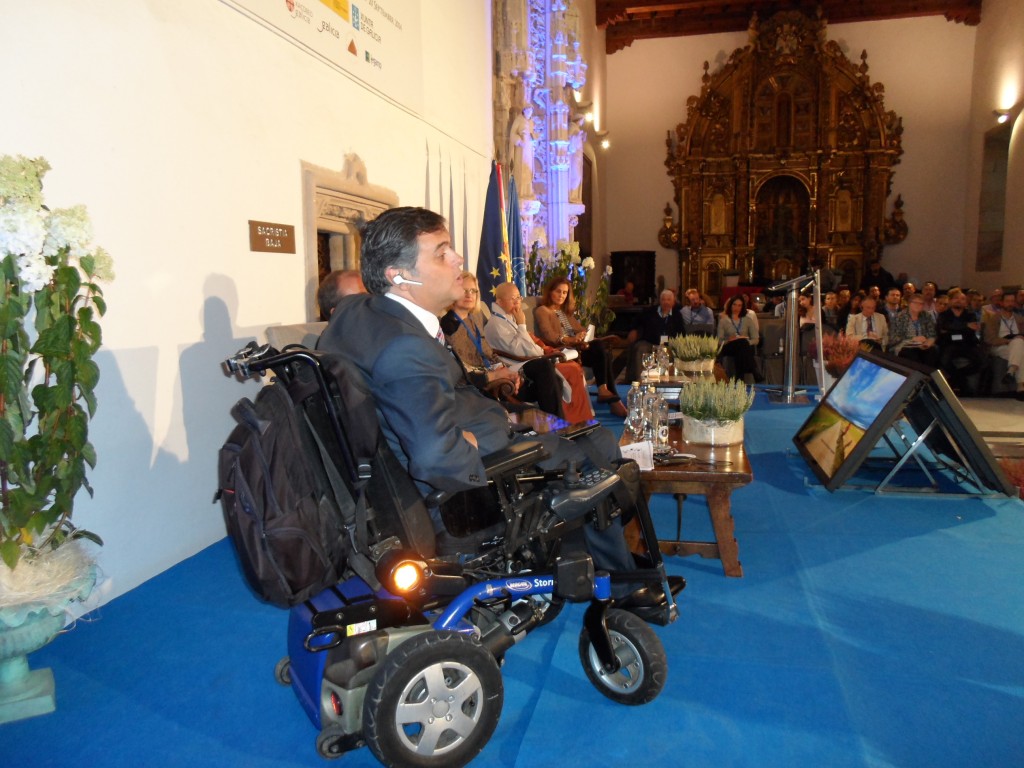 Mr. Jesús Hernández Galán, Director of Universal Accessibility, ONCE Foundation for social inclusion of people with disabilities. |
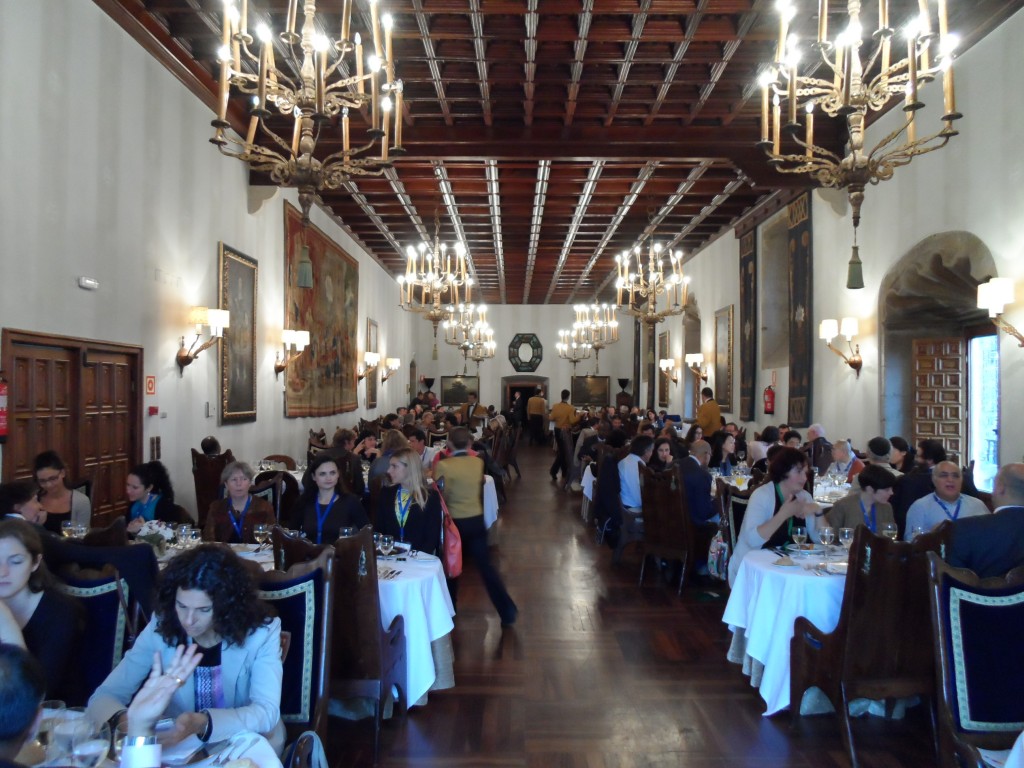 The dining room where the official luncheons were held. |
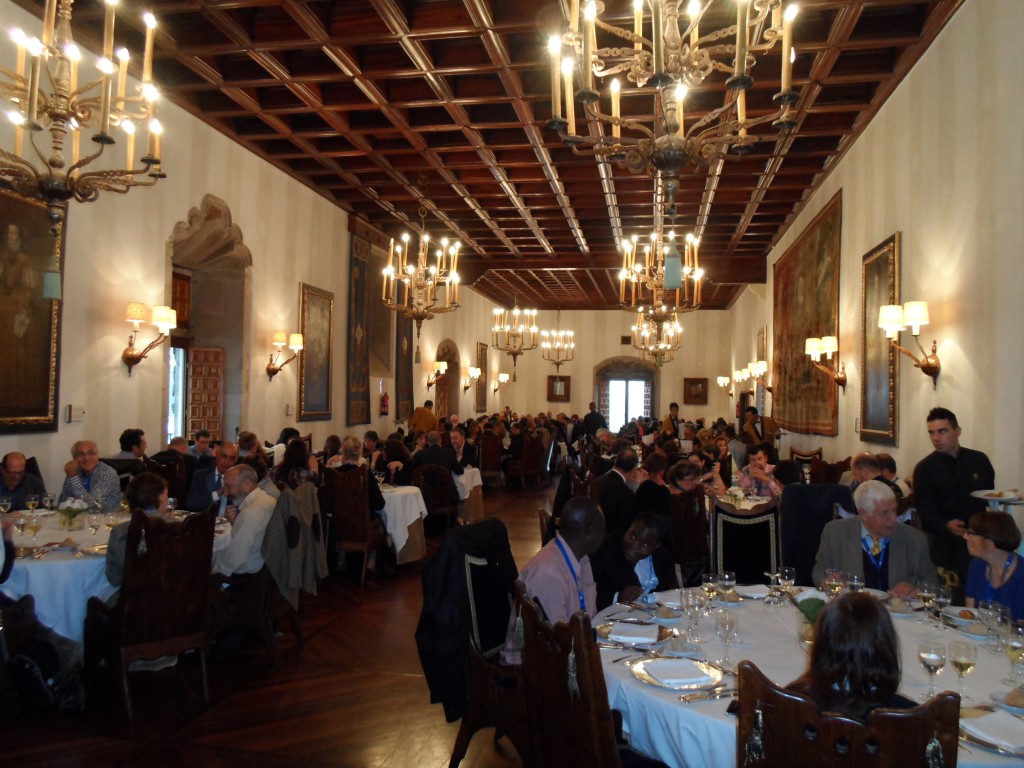 The dining room where the official luncheons were held. |
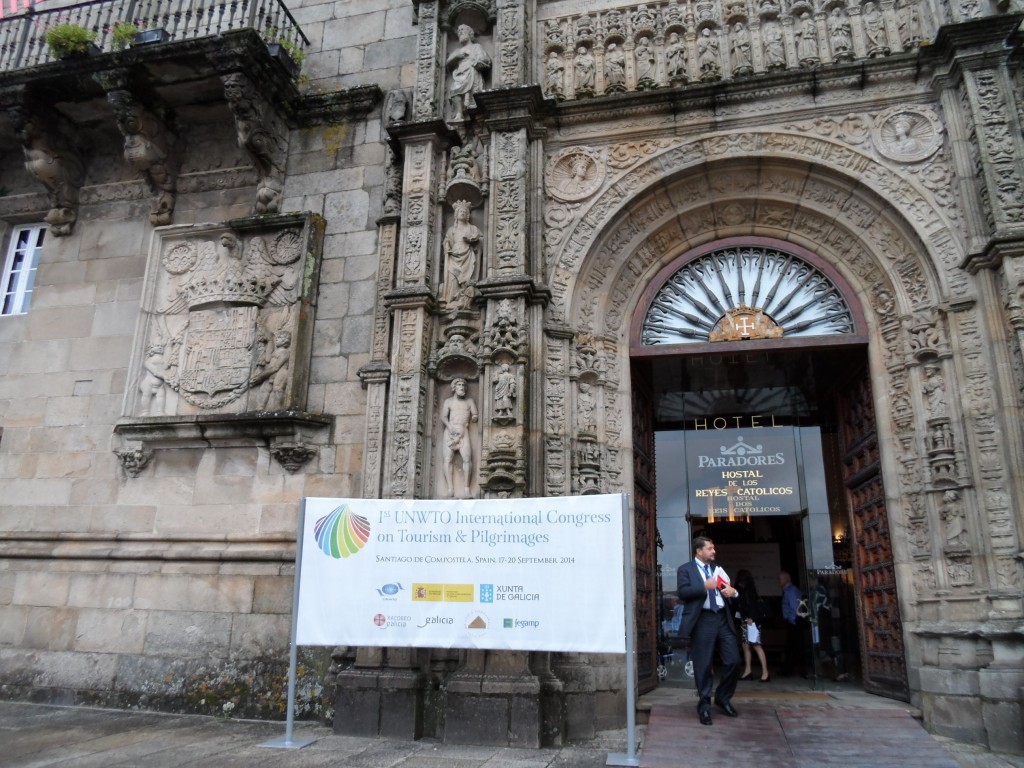 The front entrance of the Paradores hotel where the Congress was held. |
|
Synopses of the various presentations and speakers bios
|
About 120 delegates from 40 countries convened for the congress organised by the UN World Tourism Organisation, and hosted by the regional government of Galicia. Proclaimed the first European Cultural itinerary by the Council of Europe in 1987, the northern Spanish city was a perfect setting for the event. Home to a magnificent cathedral considered the third holiest place in Catholicism, it is a hub of the spiritual walks covering several hundred kilometres over what is known as the Way of St James.
In her opening remarks, Isabel María Borrego Cortés, Secretary of State for Tourism, Ministry of Industry, Energy and Tourism, Spain said it was the first such conference held in Galicia. She highlighted the role of the pilgrimages in facilitating economic recovery and job-creation during these otherwise bleak times. Pilgrims were also helping diversify Spain’s choice of product offerings beyond sea and sand, reducing the seasonality ups and downs, and enhancing the country’s competitive advantage. “Pilgrims are breathing new life into our heritage. They are helping promote sustainability, ethics and the environment,” she said. “It is one way of preserving the memories of our country and helping conserve monuments.”
Agustín Hernández Fernández de Rojas, Mayor of Santiago de Compostela, said that this city for centuries has attracted people from all over the world. Recounting how economic fortunes of the city had risen and fallen since the Middle Ages when it was one of Europe’s most important religious and cultural centers, he said the present-day influx of pilgrims, irrespective of ideology and religion, has led to an economic revival. In 2013, the city recorded 215,000 pilgrims from 150 nationalities. This year, between Jan-Aug, it has chalked up 182,000 pilgrims, up 10% up over Jan-Aug 2013.
Taleb Rifai, UNWTO Secretary-General, said that regardless of what religion one follows, “it is just a unique human experience to be in Santiago and to walk around the city.” He also lauded the choice of hotel venue, the Paradores, a restored former medieval palace that still retains its elegant grandeur and charm.
Mr. Rifai noted that the conference was taking place at a crucial time. “It takes only a little bit of watching the news on TV to realise how much the world needs more coming together and connections to the values we have. Religious intolerance is becoming predominant. We need to reinforce our faith in the human race and in life on the Planet Earth.”
Mr. Rifai said that at the same time, travel & tourism is becoming a global phenomena that is growing beyond all expectations. This year has already seen a 5% growth in international travel globally, which means there were 22 million new tourists. The positive impact on economic recovery and job-creation cannot be ignored, especially in economically-affected parts of Europe and elsewhere. UNWTO estimates indicate that there are 300-330 million annual pilgrimage visitors, making spiritual tourism a significant part of both domestic and international tourism.
Growth in religious and spiritual tourism to Spain is a clear indicator that its value goes beyond just the economic. “It is about building foundations of peace,” he said. “Pilgrimages and tourism are two of the most important global phenomena which can be instrumental in building bridges of peace and cooperation. Tourism is changing peoples around the world. We need to explore more ways to use tourism as an extension for building peace.”
Alberto Núñez Feijóo, President of the Regional Government of Galicia, said that tourism brings out the best values of humanity – communications and interactions. It is widely claimed that technology is making people more lonely. “That’s not true,” he said. “Just look at the pilgrims who have walked here or cycled here. We need to be together, walk together and to feel that somebody is by our side. The routes to Santiago are proof of that.
“We all aspire to be honourable, decent people. In that sense, we are very similar. I personally think it is much better to go on a pilgrimage than to go lie on a beach. I don’t have anything against lying on a beach, but you don’t learn anything, you don’t feel the same way and cannot use your knowledge. This (a pilgrimage) is the true tourism. Galicia is going to become the hub. We want to it put it on par with Jerusalem and The Vatican in Rome.”
He said 2021 will be a key year for pilgrims to Santiago de Compostela. That’s the next year when 25 July will fall on a Sunday, considered a special day when all sins are cleansed. A major rush is expected to Galicia and the Way of St James. By that date, Galicia is planning to have a new international centre ready to welcome pilgrims. A new master plan will also be in place to upgrade the management and infrastructure of the various pilgrim walking routes and spots.
What is driving pilgrimages these days?
In his powerful keynote address, Segundo Leonardo Pérez López, Dean of Santiago Cathedral, offered some answers. “It’s about who we are as a people. It’s all about human dignity, a quest to find answers about our very existence and who we feel we are in the contemporary world,” he said. “There are too many human insecurities these days. People are no longer happy. Current culture has become nihilistic, desperate and vulnerable. The feeling that our lives are meaningless is deeply rooted in contemporary society. But people who undertake pilgrimages can find that meaning. Pilgrimages help us to break off from what we know, and place our faith in our future.”
He added, “Pilgrimages are an inner journey. They bring together the essence of our soul and help us find the perfect image of God. You get more proof of the reality of life. By crossing rivers, plains and forests, struggling against the wind, the heat or the rain, pilgrims confront a reality that goes beyond the infinite. At every new spot, they discover a new horizon. They are walking on the way towards happiness. And then they discover the answers to the questions: What really matters? What are the values of life? Why am I here? Why do I exist? A pilgrimage is a much more than physical itinerary and overcoming the space between two points. It is all about the search for truth, the origin, meaning and destination of man.”
In a special video message to the conference, former UNESCO Director-General Federico Mayor Zaragoza said infinite diversity of the human race needs to be respected, within the context of fundamental principles enshrined in UNESCO code of ethics, such as democracy, justice and freedom. “We don’t realise how beautiful everything is — until we get there. The best way of preserving the heritage is to find out as much as we can about it.”
Representing the Vatican, Mons. José Brosel Gavilá, in charge of Tourism, Pilgrimages and Sanctuaries, Pontifical Council for the Pastoral Care of Migrants and Itinerant People, said that Christ’s entire life was a pilgrimage of sorts. “Christians see their whole life as a communion with God. The external journey is a function of the internal journey.”
Rev. Michael Kagan, Education Director of the Nava Tehila Community of Jerusalem, Israel, linked pilgrimages to the Hebrew words, Aliya l’Regel, or Uplifting the Soul. “Pilgrimages are designed to help move us out of traditional comfort zones, rising up beyond the habitual. They are a submission to the will of God, which comes with joy. This is a common denominator in all religions, including Islam and Christianity.” Referring to pilgrimages as “a life-changing activity,” he cited the Israeli familiarisation trips which bring Jews from all over the world to experience the land and visit the various spots, cities and museums of Jewish history as part of an effort to strengthen their Jewish identity.
Over the course of two days, 26 speakers presented a fascinating array of global pilgrimage spots that draw millions of people of different denominations – from the Shaolin Temple in China, famous as the home of kung-fu, to Christian holy spots in Egypt, to temple stays in Korea to the once-in-12-years Kumbh Mela in India, to indigenous peoples of Australia and the Day of Silence in Bali, to the Nejashi mosque in Ethiopia, said to be the oldest mosque in Africa. From Latin America to Africa and Asia, the presentations became vivid examples of the confluence of history and spirituality, and the ceaseless human pursuit of trust, security, good health and happiness.
Delegates also heard about Japan’s Kumano Kodo, the only other pilgrimage road designated as a UNESCO World Heritage site. Located in Wakayama Prefecture, Japan, the Kumano Kodo and Galicia Province are bound by a sister road agreement, bridging East and West. Kumano Kodo’s main routes run from the ancient capital of Kyoto to the Kumano Sanzan (Kumano Hongu Taisha Shrine, Kumano Hayatama Taisha Shrine, and Kumano Nachi Taisha Shrine).
On the third day, Mr. Jin Yung Woo, Special Adviser to the UNWTO Secretary General on Tourism and Culture, described pilgrimages as being “touching moments of self-examination and introspection.” Describing his visit to the Nejashi mosque, he said, “Even though I am of a different religion, visiting (the mosque) helped me discover how such places could contribute to peace and reconciliation between Christians and Muslims.”
He said the UNWTO global code of ethics is a roadmap for responsible tourism as it endeavours to promote human rights, equality, solidarity, tolerance, respect for nature and shared responsibilities. “Pilgrimage tourism has three important benefits: First, it could enhance the co-existence between different religions. Second, it can increase the development of Tourism. Third, it will give visitors a time of self-regeneration.” He said he would like to more attention being paid to the important role of secular pilgrimage tourism and maximise its positive influence. “In order to be more sustainable and more responsible, tourism and culture need to work together more than ever before,” Mr. Woo said.
One of the most powerful statements came from the last speaker, Mr. Jesús Hernández Galán, Director of Universal Accessibility, ONCE Foundation for social inclusion of people with disabilities. He said that whatever is done to promote pilgrimages and/or tourism, it would be remain incomplete until full accessibility could be assured for PwDs.
Highlighting the problems he has with vans, trains and other forms of transport, he said he has to travel with a personal assistant. “Hotels think we are a couple,” he said. “I have to explain to them that we need an extra bed in the room.” Noting that ageing demographics will mean that two billion people worldwide will be over 60 by 2025 which will create immense challenges for the entire travel and hospitality sectors. “This is just not just an issue for governments or the private sector. Everyone has to get involved in making the world easier for people with disabilities. Making all public facilities for more accessible is equally as important as restoring monuments and showing respect for environment and heritage.”
Although most of the focus was on the spiritual side of the pilgrimages, several comments and questions raised during the sessions queried the “tourism” component, the business side of pilgrimages, essentially the suppliers of products and services for the millions of visitors, both pilgrims and non-pilgrims. As in many other areas such as ecotourism and cultural tourism, the all-too-familiar questions facing the pilgrimage sites are carrying capacity, balancing the needs of the locals and the visitors and management to prevent overcrowding and provide fundamental municipal services.
One commentator voiced serious concern about the growing numbers, describing pilgrimages and tourism as being as incompatible as “oil and water”. Another questioner raised the game even higher; after listening to the various stories from the East, such as Buddhist temple-stays, Bali’s Day of Silence and China’s Shaolin temple, he asked how western countries with their economic crises and the rise of hyper-nationalism could learn and benefit from the traditions of the East.
The conference attracted a broad motley of delegates. The Iraqi Ministry of Tourism & Antiquities sent a representative to study ways of developing its religious spots, which are already attracting millions of Muslim pilgrims. So did the Iranian Culture and Heritage Organisation. The owner/operator of a jungle safari lodge in Tanzania also attended, as did the CEO of an agribusiness from Ukraine, a young man who in 2013 completed one of the 200-kilometre walking routes. A representative of the Abrahamic Path Initiative was also present.
The technical tour on the last day gave delegates a brief glimpse of the Way of St James. After walking a fractional, four-kilometre section of one of the several routes, delegates boarded a coach and drove along the magnificent northern coastline of Spain. After stopping at a small church, they visited the final point of one of the walking routes, known as the “End of the World.” It was a wet and somewhat cold day, but that only raised the level of respect for the many pilgrims we saw walking along the route, with backpacks, walking sticks and raincoats.
This congress is the third of its kind organised by the UNWTO on similar themes. The first International Conference on Tourism, Religions and Dialogue of Cultures was held in Córdoba, Spain, on 31 October 2007. The first International Conference on Spiritual Tourism for Sustainable Development was held in November 2013 in Ninh Binh City, Vietnam. Coming up next is the world’s first ministerial-level conference on tourism and culture to be held in Siem Reap, home of the World Heritage temple complex of Angkor Wat, between February 4-6, 2015. It will be jointly organised by the UNWTO in cooperation with UNESCO. While all the other events combining tourism and culture have been held at the regional level, this will be the first global and ministerial conference on the subject.
The primary challenge now is to mainstream this strategic agenda, give it more exposure at international travel shows and incorporate it into speeches and policy statements of industry decision-makers. The UNWTO has clearly given it the impetus it deserves. If other global travel organisations do not grasp the baton, they should be prepared to be held accountable by future generations.
